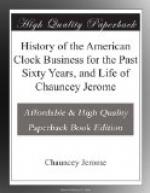take it from me, but not meeting any, I arrived safely
home, feeling greatly encouraged and happy. I
told my wife that I would make another payment on our
house, which I did with a great deal of satisfaction.
After this I was so anxious to get along with my work
that I did not so much as go out into the street for
a week at a time. I would not go out of the gate
from the time I returned from church one Sunday till
the next. I loved to work as well as I did to
eat. I remember once, when at school, of chopping
a whole load of wood, for a great lazy boy, for one
penny, and I used to chop all the wood I could get
from the families in the neighborhood, moonlight nights,
for very small sums. The winter after I made this
large sale, I took about one dozen of the Pillar Scroll
Top Clocks, and went to the town of Wethersfield to
sell them. I hired a man to carry me over there
with a lumber wagon, who returned home. I would
take one of these clocks under each arm and go from
house to house and offer them for sale. The people
seemed to be well pleased with them, and I sold them
for eighteen dollars apiece. This was good luck
for me. I sold my last one on Saturday afternoon.
There had been a fall of snow the night before of
about eight or ten inches which ended in a rain, and
made very bad walking. Here I was, twenty-five
miles from home, my wife was expecting me, and I felt
that I could not stay over Sunday. I was anxious
to tell my family of my good luck that we might rejoice
together. I started to walk the whole distance,
but it proved to be the hardest physical undertaking
that I ever experienced. It was bedtime when
I reached Farmington, only one-third the distance,
wallowing in snow porridge all the way. I did
not reach home till near Sunday morning, more dead
than alive. I did not go to church that day, which
made many wonder what had become of me, for I was always
expected to be in the singers’ seat on Sunday.
I did not recover from the effects of that night-journey
for a long time. Soon after this occurrence, I
began to increase my little business, and and employed
my old joiner “boss” and one of his apprentices;
bought my mahogany in the plank and sawed my own vaneers
[sic] with a hand-saw. I engaged a man with a
one horse wagon to go to New York after a load of
mahogany, and went with him to select it. The
roads were very muddy, and we were obliged to walk
the whole distance home by the side of the wagon.
I worked along in this small way until the year 1821,
when I sold my house and lot, which I had almost worshipped,
to Mr. Terry; it was worth six hundred dollars.
He paid me one hundred wood clock movements, with
the dials, tablets, glass and weights. I went
over to Bristol to see a man by the name of George
Mitchell, who owned a large two story house, with a
barn and seventeen acres of good land in the southern
part of the town, which he said he would sell and
take his pay in clocks. I asked him how many of
the Terry Patent Clocks he would sell it for; he said
two hundred and fourteen. I told him I would
give it, and closed the bargain at once. I finished
up the hundred parts which I had got from Mr. Terry,
exchanged cases with him for more, obtained some credit,
and in this way made out the quantity for Mitchell.




